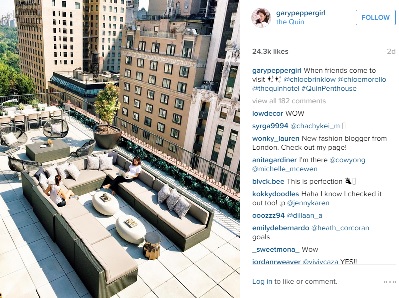Your next executive appointment: a social media influencer
 It’s all too easy nowadays for marketing messages to be avoided. In such a super-saturated time it seems obvious to say this but, nevertheless, it’s true. Print advertising is growing less effective; ad-blocking software fights against pop-ups and intrusive Google Ads; and YouTube has provided us all with the ultimate get out – the ‘skip ad’ button.
It’s all too easy nowadays for marketing messages to be avoided. In such a super-saturated time it seems obvious to say this but, nevertheless, it’s true. Print advertising is growing less effective; ad-blocking software fights against pop-ups and intrusive Google Ads; and YouTube has provided us all with the ultimate get out – the ‘skip ad’ button.
With so many firms throwing digital campaigns in our direction, it’s a wonder any break through and connect with individuals. It’s almost like we need a guide on social media to sift the rubbish on our behalf, tell us what’s stylish, and what to buy. Well, welcome to Influencer Marketing and its cabal of hip, young things waiting to fill us all in on what’s made the cool list.
Brands – particularly in the fashion and lifestyle sector – are falling over themselves to associate with young and talented social media hotshots, but within this new segment the influencers are unlike those we would usually associate with a brand promotion. They are not film stars or footballers. They do not, necessarily, have another talent with which the brand is keen to associate. They bring a very different sort of authority – namely, a large social media following. These individuals are the bloggers, vloggers, and instagramers that come with an audience attached.
Finding the Influencers
So you have a brand that you’re keen to promote through a high-powered social media influencer, but how do you find and assess them?
The Influencer Marketing Agency – IMA for short – claims to be the leading agency for digital influencers, developing and managing influencer marketing campaigns, and the ‘home to more than 4,000 leading fashion and lifestyle bloggers, vloggers, and social influencers’ with a combined reach to more than 150m consumers.
In truth, IMA is one of a number of agencies that have popped up to match brands to young and talented social media hotshots. These agencies fall roughly into two camps: talent agencies for well-known individuals that have branched out to include social media influencers, and those spun out of social media marketing.
In this second group, it’s likely that in addition to linking your brand to the appropriate marketing stooge, they can also help create content and distribute virally, as well as measure audience insights and help with strategy and planning.
The Joyn London agency runs the Joyn Influencer Network – an ‘invite-only community of global taste makers, emerging talent, industry insiders, media influencers and celebrities’. The service they offer is the ability to link a brand to the ‘creativity and social influence of the members of this community’.
When London health club chain Gymbox wanted to become a lifestyle brand, for example, Joyn developed a marketing campaign and – based on available social data – devised a nine-month programme of content with key music, fashion, and design influencers.
The marketing push was aimed to back up the opening of two new clubs, a clothing line, and a collaboration recording venture. It included a street-style competition to help the brand gain valuable social media credibility and an ambassador campaign with body-building champion Matt ‘the Pillar’ Miller.
These moves, it claims, helped engage with a new ‘lifestyle’ audience across social media channels and increase web traffic by 45 per cent.
Influencer hierarchy
Her name may not be immediately recognisable to many but that hasn’t stopped Nicole Warne becoming one of the leading digital influencers through her fashion, travel and lifestyle blog, Gary Pepper Girl, and associated social media platforms. The Gary Pepper Girl Instagram account, for example, is followed by 1.4m people.
With such a strong social media pull, Nicola has been able to work with premium brands Louis Vuitton, Dolce & Gabbana, L’Oréal Luxe, Lane Crawford and Roland Mouret. Nicola has also been featured in Vogue, Harper’s Bazaar, Elle, Glamour, and Grazia. She has even been on the cover of Miss Vogue in her native Australia.
But social media influence isn’t just about high-level, tier-one individuals working directly with a brand and agency to shape content. If you’re running a campaign, you’re going to need back-up – and for that you’re going to need amplification.
Any large social media campaign is likely to need a supporting cast of taste-makers – a second rung – to ensure messages are spread wide. A third group, bigger still, will be needed to attract individuals to campaign essentials – things like hashtags.
All of a sudden that’s a lot of pretty young things and a lot of social media clout; so how do you ensure they all stay on-message, and how do you reward them for their efforts?
Currently, most brands have someone fairly lowly in their marketing or communication team with the title of Social Media Manager or similar. These are the people who write and send out tweets, update the Pinterest board, and feed Instagram.
It looks likely that in the short-to-medium term they could have their hands full, a substantial budget, and increasing influence in the company.
There are a lot of key strategic decisions to be made before engaging a team of social media influencers, or making a head of social influence your next executive appointment, but these considerations might be coming sooner than you think.